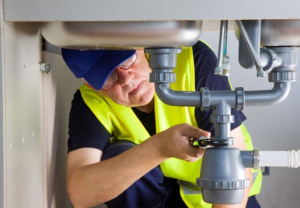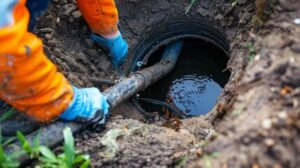Plumbing Lexington KY is the system of pipes, fixtures, and appliances that supply water and remove waste in homes and businesses. It is important for the health and safety of people inside buildings and for protecting the environment from pollution.
Like any job, being a plumber has its ups and downs. However, the rewards can be great for those who take the time to learn and develop their skills.

A reliable plumbing system is essential to a home or building’s safety and comfort. Plumbers install and repair pipes, fixtures, and appliances that deliver potable water and remove wastewater and waste materials. They also ensure that water and sewage systems are safely connected to public water and sewer lines.
Before beginning a plumbing installation project, a plumber must assess the building’s needs and lay out the best route for the new pipes. This involves measuring the space to determine what size pipe is needed and ensuring that the walls and floors can support the added weight of the piping. The plumber then creates a plan for where the piping will be installed, making sure to follow all local plumbing codes and regulations. Once the piping is ready to be installed, the plumber tests it for leaks. If any problems are found, they must be fixed before the piping can be put into use.
Once the piping is in place, a plumber connects the fixtures to the piping using the proper fittings and clamps. This includes connecting sinks and faucets to the hot- and cold-water lines, as well as drains and sewage lines. Fixtures include bathtubs, showers, sinks, laundry tubs, kitchen and bathroom faucets, and toilets. In some homes, washing machines, dishwashers, ice makers, and humidifiers may also be connected to the plumbing.
The drainage plumbing system takes the sewage and wastewater from fixtures and transports it to the sewer line or septic tank. It is important that this plumbing work is done correctly to avoid sewage leaks, which can cause serious health risks.
Plumbing can seem like an intimidating task, but it’s actually quite simple once you understand the basics. The most important thing to remember is that a plumbing system is an entire network of interconnected parts, each of which must be working properly for the whole system to function. A good plumber will know how to plan his or her work efficiently, so that the system is easy to maintain and no part of the piping is overcrowded or overworked. He or she will also have a good understanding of how to install pipes without weakening the framing, so that future repairs will be as cost-effective as possible.
Repair
Plumbing repair is the process of fixing damaged or broken pipes, fixtures, faucets, and other parts of a home’s plumbing system. It is important to have quality plumbing repairs done by a professional plumber to ensure the health and safety of residents. Plumbing repair can range from unclogging a drain to replacing a water heater. It is also important to hire a plumber with experience working on your type of plumbing system.
Some common plumbing repair issues include leaky or clogged pipes, toilets that don’t flush properly, and water filters that aren’t filtering properly. These problems can occur in both residential and commercial buildings. Professional plumbers can diagnose and fix these problems quickly and effectively to ensure the plumbing system is functioning properly.
When performing plumbing repairs, it is important to use the right tools and equipment for the job. This will help to prevent further damage and keep the plumbing system running efficiently for years to come. It is also important to follow the manufacturer’s instructions for the specific pipe or fixture being repaired. Using the wrong tools or not following the manufacturer’s instructions can lead to further damage and expensive plumbing repairs down the road.
Leaky pipes are a common plumbing issue that requires immediate attention. If left unattended, leaky pipes can cause flooding and major water damage to the home or business. It is important to shut off the water supply before beginning any work on a leaky pipe. The valve can usually be found under the sink or in the basement near the leaky pipe. If there is no shut-off valve near the leaky pipe, it may be necessary to turn off the main water supply to the building. It is also a good idea to place a bucket or a puddle under the leaky pipe to catch any water that might spill during the repair process.
Besides repairing leaks, plumbers can also help homeowners reduce their energy bills by installing energy-efficient appliances and fixtures. They can also advise on and help with water conservation practices, such as using low-flow showerheads and toilets, and implementing rainwater collection systems for gardening and washing cars.
Maintenance
Over time, wear and tear naturally occurs on plumbing fixtures and fittings. This can result in small leaks and clogs, which, if left unchecked, can cause water waste and increase utility bills. Keeping on top of these issues through routine maintenance helps prolong the lifespan of plumbing systems and reduces the need for expensive repairs.
Routine plumbing maintenance includes inspections of pipes, drains, and fixtures to detect early problems that could become more severe if left unchecked. This includes checking for water leaks, identifying the source of a clog, and preventing further damage by cleaning or repairing faulty components.
Similarly, addressing aging plumbing by installing new components or replacing old and worn-out fixtures helps reduce the likelihood of future issues and ensures that plumbing systems continue to operate efficiently. This preventive approach also enhances the value of a property and improves tenant comfort and satisfaction.
Some plumbing maintenance tasks are best performed seasonally. For example, flushing water heaters annually and insulating exposed pipes in cold climates can help prevent frozen and burst pipes. Likewise, periodic sewer line inspections can identify and address issues like clogs caused by tree roots or buildup of grease.
The condition of a property’s plumbing can affect its overall value, so it’s important for owners and managers to invest in proactive maintenance. This helps protect the value of a property, maintains occupant safety and comfort, and improves the overall appeal of the building.
Plumbing emergencies are stressful and costly, but they can be avoided with regular maintenance. The most common causes of plumbing emergencies include a burst pipe, severe clog, or broken water heater. These problems can occur for a variety of reasons, including ageing and environmental factors. By conducting regular maintenance and identifying potential issues, they can be addressed before they lead to costly repairs or disruptions to a home’s daily operations.
Regular plumbing maintenance is vital to a property’s safety and longevity, but it can be difficult for owners and tenants to keep on top of these tasks. By working with a professional plumber, property owners can ensure that all maintenance is carried out consistently and correctly, which helps to minimise downtime and unnecessary costs. In addition, implementing a comprehensive CMMS system that records all maintenance work and technician feedback can make it easier to track and forecast maintenance needs.
Replacement
Even with the best care, plumbing fixtures and fittings wear out over time. When they do, it’s usually more cost-effective to replace them than repair them. However, deciding whether to repair or replace can be difficult. A good plumber can help you evaluate your options and choose a solution that fits your budget.
The system of pipes and fixtures that brings water into buildings and removes wastewater, including toilets, bathtubs, showers, sinks, and faucets. It can also include drains, vents, and water heaters. Modern plumbing uses nontoxic materials, unlike the lead pipes common in older homes. Water pipes are normally concealed behind walls and under floors, while fixtures are mounted on or above the surfaces they serve. Some common signs that your plumbing needs replacing are discolored water, decreased water pressure, or clogged drains and toilets.
